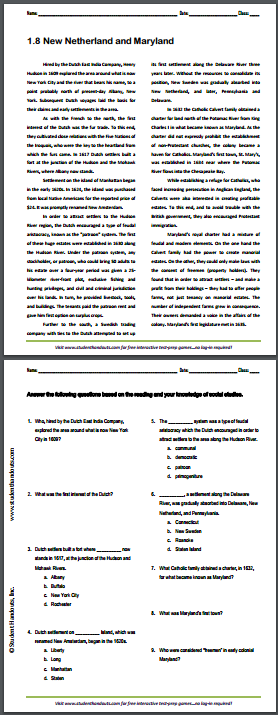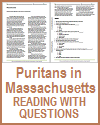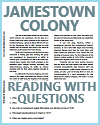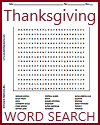New Netherland and Maryland |
 Hired by the Dutch East India Company, Henry Hudson in 1609
explored the area around what is now New York City and the river
that bears his name, to a point probably north of present-day
Albany, New York. Subsequent Dutch voyages laid the basis for
their claims and early settlements in the area. Hired by the Dutch East India Company, Henry Hudson in 1609
explored the area around what is now New York City and the river
that bears his name, to a point probably north of present-day
Albany, New York. Subsequent Dutch voyages laid the basis for
their claims and early settlements in the area.As with the French to the north, the first interest of the Dutch was the fur trade. To this end, they cultivated close relations with the Five Nations of the Iroquois, who were the key to the heartland from which the furs came. In 1617 Dutch settlers built a fort at the junction of the Hudson and the Mohawk Rivers, where Albany now stands. Settlement on the island of Manhattan began in the early 1620s. In 1624, the island was purchased from local Native Americans for the reported price of $24. It was promptly renamed New Amsterdam. In order to attract settlers to the Hudson River region, the Dutch encouraged a type of feudal aristocracy, known as the "patroon" system. The first of these huge estates were established in 1630 along the Hudson River. Under the patroon system, any stockholder, or patroon, who could bring 50 adults to his estate over a four-year period was given a 25-kilometer river-front plot, exclusive fishing and hunting privileges, and civil and criminal jurisdiction over his lands. In turn, he provided livestock, tools, and buildings. The tenants paid the patroon rent and gave him first option on surplus crops. Further to the south, a Swedish trading company with ties to the Dutch attempted to set up its first settlement along the Delaware River three years later. Without the resources to consolidate its position, New Sweden was gradually absorbed into New Netherland, and later, Pennsylvania and Delaware. In 1632 the Catholic Calvert family obtained a charter for land north of the Potomac River from King Charles I in what became known as Maryland. As the charter did not expressly prohibit the establishment of non-Protestant churches, the colony became a haven for Catholics. Maryland's first town, St. Mary's, was established in 1634 near where the Potomac River flows into the Chesapeake Bay. While establishing a refuge for Catholics, who faced increasing persecution in Anglican England, the Calverts were also interested in creating profitable estates. To this end, and to avoid trouble with the British government, they also encouraged Protestant immigration. Maryland's royal charter had a mixture of feudal and modern elements. On the one hand the Calvert family had the power to create manorial estates. On the other, they could only make laws with the consent of freemen (property holders). They found that in order to attract settlers – and make a profit from their holdings – they had to offer people farms, not just tenancy on manorial estates. The number of independent farms grew in consequence. Their owners demanded a voice in the affairs of the colony. Maryland's first legislature met in 1635. |
Directions: Read the text above, then answer the
questions below. |
|
1. Who, hired by the
Dutch East India Company, explored the area around what is now
New York City in 1609? 2. What was the first interest of the Dutch? 3. Dutch settlers built a fort where
__________ now stands in 1617, at the junction of the Hudson and
Mohawk Rivers. a. Albany b. Buffalo c. New York City d. Rochester 4. Dutch settlement on __________ Island,
which was renamed New Amsterdam, began in the 1620s. a. Liberty b. Long c. Manhattan d. Staten 5. The __________ system was a type of feudal
aristocracy which the Dutch encouraged in order to attract
settlers to the area along the Hudson River. a. communal b. democratic c. patroon d. primogeniture 6. __________, a settlement along the
Delaware River, was gradually absorbed into Delaware, New
Netherland, and Pennsylvania. a. Connecticut b. New Sweden c. Roanoke d. Staten Island 7. What Catholic family obtained a charter,
in 1632, for what became known as Maryland? 8. What was Maryland's first town? 9. Who were considered "freemen" in early colonial Maryland? |
Click here to print this worksheet. |
 |
| Early America Books and Films | Early America Image Galleries |
| Early America Learning and Study Games | Early America Miscellany |
| Early America Outlines and PowerPoints | Early America Worksheets |
Text courtesy of the U.S. State Department,
Bureau of International Information Programs, 2005 |











